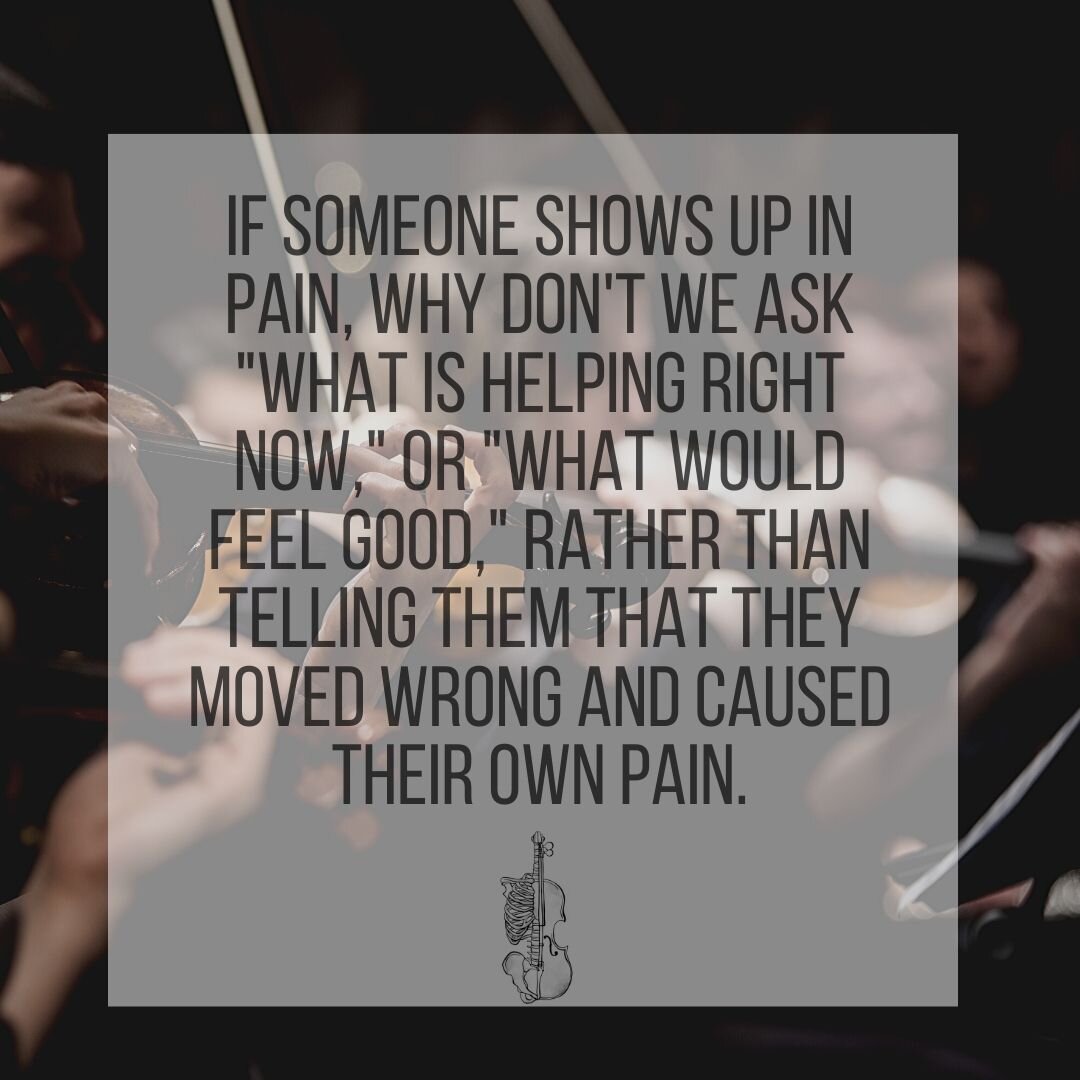"If It Hurts, You're Doing It Wrong" and other Confusing Proclamations
In music and movement, we often hold strong opinions about the “right” way to move, play, or complete a task. One comment thread I read this past week was about the famous violin soloist Janine Jansen, and her cancellation of concerts due to injury, and the comment was "If someone hurts while playing their instrument, they're doing it wrong." Many of the other comments proceeded to nit pick her photos and videos for signs of misalignment, and then proclaim one method or approach as the solution. I see this concept in so many different disciplines- music, yoga culture, pilates, athletics, and more, but it is incredibly short-sighted in light of the many different factors that affect injury.
If someone has pain while walking, running, and completing everyday activities, do we initially assume they're doing everything "wrong?" Probably not, although there are factors in all of those activities that increase and decrease healthfulness.
What if a professional athlete injures himself (or herself)? Is the assumption that their form in their sport is "wrong,” even if that very form is what allowed them to excel above others? If a normal person injures themselves running even though they’ve run for years, are they doing it wrong even though it worked before? In regards to music, the action of making music and studying music for twenty plus years is a complex process, involving many areas of fine motor control, skill acquisition, coordination, proprioception, adaptation, and more. To tell someone after studying for many years that they're doing it incorrectly is essentially placing a value judgment on someone's health and abilities in music, sport, or life, despite the many different variables that affect injury and tissue damage. It’s assuming a lot of things about their life that we can’t possibly know.
Here's a truth: There are certain aspects of our technique, setup, practice habits, nutrition, sleep, and day to day self-care that can affect our long term health, mobility, and endurance. But if there was one universal, pain-free, biomechanically sound way to move, play sports, or play an instrument, we’d all be doing it. Given the biodiversity of humans, and the many ways that people move, there is a spectrum of possibilities for everything. If we compare all of the concert violinists and violists that have a “successful” career, we’d find a wide range of approaches towards playing the violin, many backgrounds, and different technical approaches. All that means is that there is bioindividuality in technique, pain, and injury. Pain can be a combination of biological factors, emotional factors, stress, job pressure, environment, and more. If someone’s neck hurts while playing violin, I can offer suggestions for other possibilities, chin rests, or awareness practices, but I can’t “fix” them. I don’t know if there’s tissue damage or if something is not “on” or if it’s “misfiring.” Sometimes good alignment helps pain, sometimes it’s not the primary culprit.
Here's another: If someone is injured, it's not necessarily their "fault" or because their setup or technique is dubious. That's not to say that we can't all expand our proprioception, refine our technique, or learn new ways of working around tension and compensation patterns, but that there are also other factors at play in injury management, including mental health, mindset, stress, sleep hygiene, and more.
Biomechanist Katy Bowman talks about frequency, duration, intensity, and other variables that affect the loads placed on a body. In terms of music study, factors might be
-size of instrument relative to the person
-frequency of rehearsals/personal practice compared to frequency of breaks
-duration of rehearsals/personal practice
-intensity level of rehearsal/personal practice
-height of chair/stand
-difficulty level of music
-an individual's other non-mudivsl activities (computer, driving, lifting, etc.)
-an individual's self-care practices (massage, strengthening, etc.)
-an individual's tissue elasticity, strength, hypermobility, arthritis, etc.
-an individual's age and gender
-an individual's relationship to pain
-stress
And so forth.
For a movement client, that might be similar
-volume of training
-adaptation to training weight or intensity
-fatigue from work or life
-hormonal or health challenges
-previous injury
-nervous system adaptability
Some of these factors include things that we can control as musicians and movement teachers, but many of these are beyond our control. As a movement teacher, I feel like I have to remind clients that if something is hard, it doesn’t mean they’re doing it wrong, and if something hurts, it may be something to pay attention to, but not necessarily correlate with tissue damage. I’m also not a clinician, have no access to imaging, and have no idea if they’re pulling a muscle, putting something “out of place” or why things are hard sometimes. If someone is experiencing pain or difficulty, we can't assume it's their fault or that they are fundamentally doing things wrong- there's no one "right way" for everyone.




